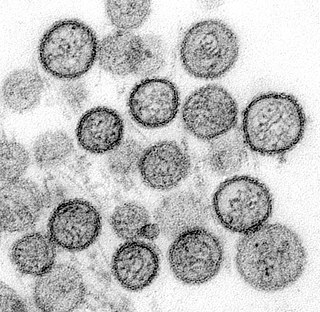
Orthohantavirus is a genus of single-stranded, enveloped, negative-sense RNA viruses in the family Hantaviridae within the order Bunyavirales. Members of this genus may be called orthohantaviruses or simply hantaviruses.

Sin Nombre orthohantavirus (SNV) is the prototypical etiologic agent of hantavirus cardiopulmonary syndrome (HCPS).
Seoul orthohantavirus (SEOV) is a member of the Orthohantavirus family of rodent-borne viruses and is one of the 4 hantaviruses that are known to be able to cause Hantavirus hemorrhagic fever with renal syndrome (HFRS). It is an Old World hantavirus; a negative sense, single-stranded, tri-segmented RNA virus.

Andes orthohantavirus (ANDV), a species of Orthohantavirus, is a major causative agent of hantavirus cardiopulmonary syndrome (HCPS) and hantavirus pulmonary syndrome (HPS) in South America. It is named for the Andes mountains of Chile and Argentina, where it was first discovered. Originating in the reservoir of rodents, Andes orthohantavirus is easily transmitted to humans who come into contact with infected rodents or their fecal droppings. However, infected rodents do not appear ill, so there is no readily apparent indicator to determine whether the rodent is infected or not. Additionally, Andes orthohantavirus, specifically, is the only hantavirus that can be spread by human to human contact via bodily fluids or long-term contact from one infected individual to a healthy person.
Playa de Oro virus (OROV) is a probable species of orthohantavirus found in the rodents Oryzomys couesi and Sigmodon mascotensis in the Mexican state of Colima. The former is thought to be the main host. The sequences of parts of the virus's RNA-based genome have been determined; they differ by 7–10% in amino acid composition and 22–24% in nucleotide composition from closely related viruses.
New York orthohantavirus or New York virus is an Orthohantavirus. It is considered a strain of Sin Nombre orthohantavirus. It was first isolated from a white-footed mouse caught on an island off New York. The virus is associated with typical hantavirus pulmonary syndrome.
Black Creek Canal orthohantavirus (BCCV) is a single-stranded, negative sense RNA virus species of New World Orthohantavirus. It was first isolated in cotton rats found in the Black Creek Canal area of Dade County, Florida in 1995. The discovery followed from an isolated case of Hantavirus pulmonary syndrome diagnosed in a Dade County resident.

The 1993 Four Corners hantavirus outbreak was an outbreak of hantavirus that caused the first known human cases of hantavirus disease in the United States. It occurred within the Four Corners region – the geographic intersection of the U.S. states of Utah, Colorado, New Mexico, and Arizona – of the Southwestern United States in mid-1993. This region is largely occupied by Native American tribal lands, including the Hopi, Ute, Zuni, and Navajo reservations, from which many of the cases were reported.
Sangassou orthohantavirus(SANGV) is single-stranded, negative-sense RNA virus species of the genus Orthohantavirus in the Bunyavirales order. It was first isolated in an African wood mouse in the forest in Guinea, West Africa in 2010. It is named for the village near where the mouse was trapped. It is the first indigenous Murinae-associated African hantavirus to be discovered.

Hantavirus hemorrhagic fever with renal syndrome (HFRS) is a group of clinically similar illnesses caused by species of hantaviruses. It is also known as Korean hemorrhagic fever and epidemic hemorrhagic fever. It is found in Europe, Asia, and Africa. The species that cause HFRS include Hantaan orthohantavirus, Dobrava-Belgrade orthohantavirus, Saaremaa virus, Seoul orthohantavirus, Puumala orthohantavirus and other orthohantaviruses. Of these species, Hantaan River virus and Dobrava-Belgrade virus cause the most severe form of the syndrome and have the highest morbidity rates. When caused by the Puumala virus, it is also called nephropathia epidemica. This infection is known as sorkfeber in Swedish, myyräkuume in Finnish, and musepest in Norwegian.

Hantavirus pulmonary syndrome (HPS) is one of two potentially fatal syndromes of zoonotic origin caused by species of hantavirus. These include Black Creek Canal virus (BCCV), New York orthohantavirus (NYV), Monongahela virus (MGLV), Sin Nombre orthohantavirus (SNV), and certain other members of hantavirus genera that are native to the United States and Canada.
Dobrava-Belgrade orthohantavirus (DOBV), also known as Dobrava virus, is an enveloped, single-stranded, negative-sense RNA virus species of Old World Orthohantavirus. It is one of several species of Hantavirus that is the causative agent of severe Hantavirus hemorrhagic fever with renal syndrome. It was first isolated in 1985 from a yellow-necked mouse found in the village of Dobrava, southeastern Slovenia. It was subsequently isolated in striped field mice in Russia and other parts of Eastern Europe. It has also been found in Germany but the reservoir host there is unknown.
Muju virus(MUV) is a zoonotic negative-sense single-stranded RNA virus of the genus Orthohantavirus. It is a member virus of Puumala orthohantavirus. It is one of four rodent-borne Hantaviruses found in the Republic of Korea. It is the etiologic agent for Hantavirus hemorrhagic fever with renal syndrome (HFRS). The other species responsible for HFRS in Korea are Seoul orthohantavirus, Hantaan orthohantavirus, and Soochong virus.
Monongahela virus (MGLV) is a single-stranded, negative-sense Orthohantavirus virus of zoonotic origin that causes hantavirus pulmonary syndrome.
Limestone Canyon virus (LSC) is a single-stranded, negative-sense RNA zoonotic Orthohantavirus that is genetically similar to Sin Nombre orthohantavirus which causes Hantavirus pulmonary syndrome (HPS) in humans. HPS causing hantaviruses are found only in the United States and South America.
Topografov virus is an enveloped, negative-sense RNA virus of the genus Orthohantavirus in the Bunyavirales order. It is the first hantavirus to be isolated from Siberian lemmings found near the Topografov River in the Taymyr Peninsula, Siberia.
Choclo orthohantavirus (CHOV) is a single-stranded, negative-sense RNA zoonotic New World hantavirus. It was first isolated in 1999 in western Panama. The finding marked the first time Hantavirus pulmonary syndrome (HPS) was found in Central America.
El Moro Canyon orthohantavirus is a single-stranded, negative sense RNA virus of the genus Orthohantavirus. It is a causative agent of Hantavirus pulmonary syndrome.
Rockport virus (RKPV) is a single-stranded, enveloped, negative-sense RNA orthohantavirus.
Oxbow virus(OXBV) is a single-stranded, enveloped, negative-sense RNA orthohantavirus.




